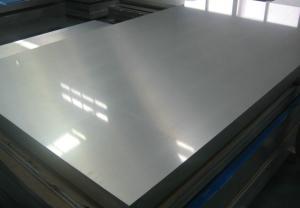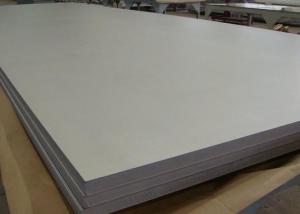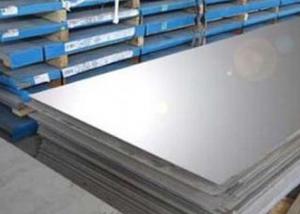304 2B Stainless Steel Sheet
- Loading Port:
- China Main Port
- Payment Terms:
- TT or LC
- Min Order Qty:
- 1 Ton m.t.
- Supply Capability:
- 5000 Tons Per Month m.t./month
OKorder Service Pledge
OKorder Financial Service
You Might Also Like
AISI 304 Stainless steel sheet
1. Chemical composition of AISI 304 Stainless steel sheet
C | Si | Mn | P | S | Ni | Cr |
max0.08 | max1.00 | max2.00 | max0.045 | max0.03 | 8.00-10.50 | 18.00-20.00 |
2. Mechanical properties of AISI 304 Stainless steel sheet
Yield Strength | Tensile | Elongation | Hardness (HV) | Hardness (HRB) |
≥ 205 | ≥ 520 | ≥ 40 | ≤ 200 | ≤ 90 |
3. Standard of AISI 304 Stainless steel sheet : AISI, ASTM, GB, EN, DIN, JIS
4. Surface of AISI 304 Stainless steel sheet : 2B, NO.1, BA, NO.4, Hairline, SB, Mirror finish, Anti-skid, Cherkered etc.
5. Size of AISI 304 Stainless steel sheet :
Thickness: 0.3-3mm (cold rolled), 3-40mm (hot rolled)
Width: 1000mm or 1219mm or 1240mm for cold rolled, 1500mm for hot rolled.
Length: As customers' request.
6. MOQ of AISI 304 Stainless steel sheet : 1 Ton
7. Payment terms of AISI 304 Stainless steel sheet : T/T or L/C
8. Packing of AISI 304 Stainless steel sheet : Seaworthy package with wooden or Iron pallets with the paper and the steel strip,
or as customers' request.
9. Delivery time of AISI 304 Stainless steel sheet : Usually about 7 days after we confirming the order, or according to your quantity.
If you have any demand, pls feel free to contact me.
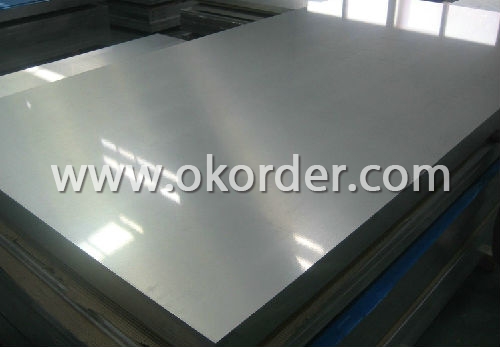
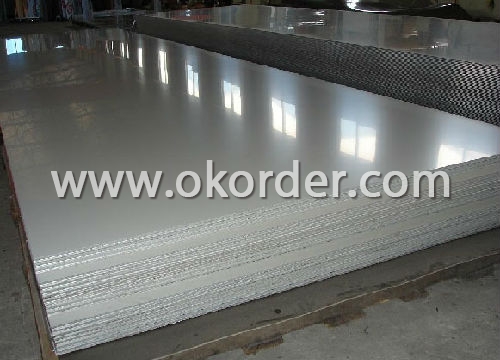
- Q:Are stainless steel strips resistant to hydrogen sulfide corrosion?
- Yes, stainless steel strips are generally resistant to hydrogen sulfide corrosion due to the alloy's high chromium content which forms a protective oxide layer on the surface, preventing the corrosive effects of hydrogen sulfide.
- Q:How do stainless steel strips handle exposure to sulfuric acid?
- Stainless steel strips possess outstanding corrosion resistance properties, rendering them suitable for a vast array of applications. When confronting sulfuric acid, stainless steel strips commonly exhibit favorable performance, contingent upon the acid's concentration and temperature. Stainless steel comprises a substantial quantity of chromium, which generates a protective layer on the surface upon exposure to oxygen. This inactive layer acts as a shield against corrosive elements, including sulfuric acid. Nevertheless, the effectiveness of this layer may be compromised under specific circumstances. In diluted sulfuric acid solutions, stainless steel strips exhibit commendable resistance. The inactive layer remains intact, safeguarding the steel against corrosion. However, in scenarios involving higher concentrations or elevated temperatures, the inactive layer may become vulnerable to attack. Under such circumstances, it is advisable to opt for stainless steel grades with increased chromium and nickel content, such as 316 or 317. These alloys offer enhanced resistance to sulfuric acid, even in high concentrations and temperatures. Furthermore, the addition of molybdenum to the stainless steel composition can further augment its resistance to sulfuric acid. It is important to bear in mind that prolonged exposure to sulfuric acid can eventually result in corrosion, even in the most resistant stainless steel grades. Hence, regular inspections and maintenance play a crucial role in ensuring the durability of stainless steel strips within sulfuric acid environments. In conclusion, stainless steel strips generally exhibit satisfactory performance when exposed to sulfuric acid, particularly in diluted solutions. Nonetheless, for higher concentrations and temperatures, it is recommended to select the appropriate stainless steel grade with greater chromium, nickel, and possibly molybdenum content to guarantee optimal corrosion resistance.
- Q:Can stainless steel strips be used in pharmaceutical storage containers?
- Yes, stainless steel strips can be used in pharmaceutical storage containers. Stainless steel is a commonly used material in the pharmaceutical industry due to its excellent corrosion resistance and durability. It is highly resistant to chemicals and can withstand harsh cleaning agents and disinfectants, making it an ideal choice for storing pharmaceutical products. Stainless steel strips can be used to construct pharmaceutical storage containers, ensuring the integrity and safety of the stored drugs. Additionally, stainless steel is non-reactive and does not leach any harmful substances into the stored medications, ensuring their purity and effectiveness. Overall, stainless steel strips are a reliable and suitable material for pharmaceutical storage containers.
- Q:How do you determine the mechanical properties of a stainless steel strip?
- To determine the mechanical properties of a stainless steel strip, various testing methods can be employed. These include tension tests to measure the strip's ultimate tensile strength, yield strength, and elongation. Hardness tests can be conducted to determine the strip's resistance to indentation or scratching, while impact tests can assess its ability to withstand sudden forces. Additionally, bending tests can help determine the strip's flexibility and ductility. Overall, a combination of these tests provides a comprehensive understanding of the mechanical properties of a stainless steel strip.
- Q:Are stainless steel strips suitable for architectural applications?
- Yes, stainless steel strips are suitable for architectural applications. They are highly durable, corrosion-resistant, and have an aesthetically pleasing appearance, making them ideal for various architectural purposes such as cladding, decorative elements, and structural components.
- Q:What is the shear strength of stainless steel strips?
- The shear strength of stainless steel strips can vary depending on a range of factors, including the composition of the alloy, the tempering process, and the thickness of the strips. Stainless steel generally possesses superior mechanical properties and resistance to deformation, resulting in a higher shear strength compared to other materials. Typically, stainless steel strips have a shear strength ranging from 150 to 300 megapascals (MPa). However, it is crucial to note that this range can vary significantly depending on the grade of stainless steel used. For instance, austenitic stainless steel grades like 304 and 316 are commonly employed in industrial applications and typically exhibit a higher shear strength than ferritic or martensitic stainless steels. These grades can have a shear strength ranging from 150 to 275 MPa. On the contrary, martensitic stainless steel grades such as 410 or 420 contain a higher carbon content, which increases hardness and shear strength. These grades can possess a shear strength ranging from 250 to 300 MPa. Furthermore, the thickness of the stainless steel strips can impact their shear strength. Thicker strips generally exhibit a higher shear strength due to the larger cross-sectional area, which provides more resistance to shearing forces. To obtain accurate information regarding the shear strength of specific stainless steel strips, it is advisable to consult the technical data sheet or manufacturer's specifications. Additionally, conducting tests or seeking guidance from a materials engineer or metallurgist can offer more precise and tailored information based on the particular application and conditions.
- Q:Can stainless steel strips be used in the production of chemical tanks?
- Yes, stainless steel strips can be used in the production of chemical tanks. Stainless steel is known for its excellent corrosion resistance, making it a suitable material for holding and transporting various chemicals. The use of stainless steel strips in the construction of chemical tanks ensures durability, longevity, and resistance against chemical reactions that can occur within the tanks. Additionally, stainless steel's strength and ability to withstand high temperatures make it a reliable choice for storing and transporting chemicals safely.
- Q:What are the maximum operating temperatures for stainless steel strips?
- The maximum operating temperatures for stainless steel strips differ based on the grade of stainless steel in use. In most cases, stainless steel strips can handle temperatures ranging from 1500°F to 1600°F (815°C to 870°C). It is crucial to consider that temperature limits can vary due to factors like alloy composition, surface finish, and intended application. Thus, it is advisable to refer to the manufacturer's specifications or seek expert advice to ascertain the precise maximum operating temperature for a particular grade of stainless steel strips.
- Q:How do stainless steel strips resist stress corrosion cracking in chloride environments?
- Due to their inherent properties and specific alloy composition, stainless steel strips exhibit a high resistance to stress corrosion cracking in chloride environments. This resistance is primarily attributed to the presence of chromium, molybdenum, and nickel in the stainless steel alloy. Chromium, as the main component, is responsible for the corrosion resistance of stainless steel. When exposed to chloride ions, the stainless steel strips develop a passive oxide layer consisting of chromium oxide on their surface. This oxide layer acts as a protective barrier, preventing the penetration of chloride ions and reducing the likelihood of stress corrosion cracking. Molybdenum, another crucial element in stainless steel alloys, enhances their resistance to stress corrosion cracking in chloride environments. It provides additional protection by increasing the material's resistance to pitting and crevice corrosion, which can be precursors to stress corrosion cracking. Moreover, the presence of molybdenum improves the overall strength and durability of the stainless steel strips. Nickel, as an alloying element, further enhances the resistance of stainless steel strips to stress corrosion cracking. It enhances the material's ability to withstand the corrosive effects of chloride ions, minimizing the risk of crack initiation and propagation. Apart from these alloying elements, the specific composition and microstructure of the stainless steel strips also play a crucial role in their resistance to stress corrosion cracking. Optimal resistance to chloride-induced corrosion is achieved by selecting an appropriate stainless steel grade with a higher content of chromium, molybdenum, and nickel, such as 316 or 904L. Additionally, proper fabrication processes and surface treatments, like passivation, can further enhance the corrosion resistance of stainless steel strips in chloride environments. Passivation involves the removal of iron contaminants from the surface and the formation of a more uniform and protective chromium oxide layer, further reducing the risk of stress corrosion cracking. In conclusion, stainless steel strips possess a remarkable resistance to stress corrosion cracking in chloride environments due to the combined effects of chromium, molybdenum, and nickel, as well as their specific alloy composition, microstructure, and surface treatments. These factors make stainless steel a preferred choice for various industries, including marine, chemical, and oil and gas.
- Q:What are the standard dimensions for stainless steel strips?
- The standard dimensions for stainless steel strips can vary depending on the specific application and industry requirements. However, some common standard dimensions include thicknesses ranging from 0.1mm to 3.0mm, widths ranging from 10mm to 600mm, and lengths ranging from 1000mm to 6000mm. These dimensions are commonly used in various industries such as automotive, construction, and manufacturing. It is important to note that these dimensions can be customized based on the specific needs of a project or application.
1. Manufacturer Overview |
|
|---|---|
| Location | Changsha,China |
| Year Established | 2003 |
| Annual Output Value | Above US$36 billion |
| Main Markets | Mid East;Western Europe;North America |
| Company Certifications | ISO 9001:2008; |
2. Manufacturer Certificates |
|
|---|---|
| a) Certification Name | |
| Range | |
| Reference | |
| Validity Period | |
3. Manufacturer Capability |
|
|---|---|
| a)Trade Capacity | |
| Nearest Port | Changsha |
| Export Percentage | 0.8 |
| No.of Employees in Trade Department | 160,000 People |
| Language Spoken: | English;Chinese;Japanese |
| b)Factory Information | |
| Factory Size: | Above 3,000,000 square meters |
| No. of Production Lines | Above 10 |
| Contract Manufacturing | OEM Service Offered;Design Service Offered |
| Product Price Range | Average |
Send your message to us
304 2B Stainless Steel Sheet
- Loading Port:
- China Main Port
- Payment Terms:
- TT or LC
- Min Order Qty:
- 1 Ton m.t.
- Supply Capability:
- 5000 Tons Per Month m.t./month
OKorder Service Pledge
OKorder Financial Service
Similar products
New products
Hot products
Hot Searches
Related keywords
